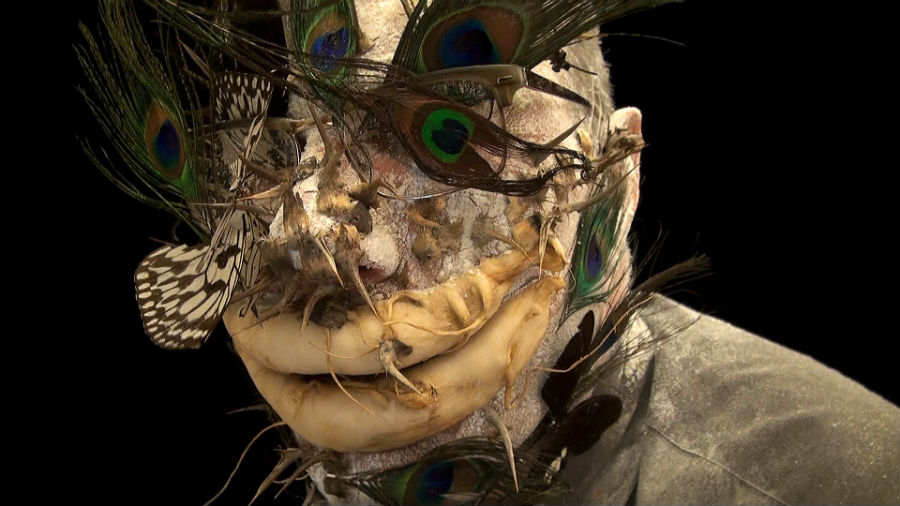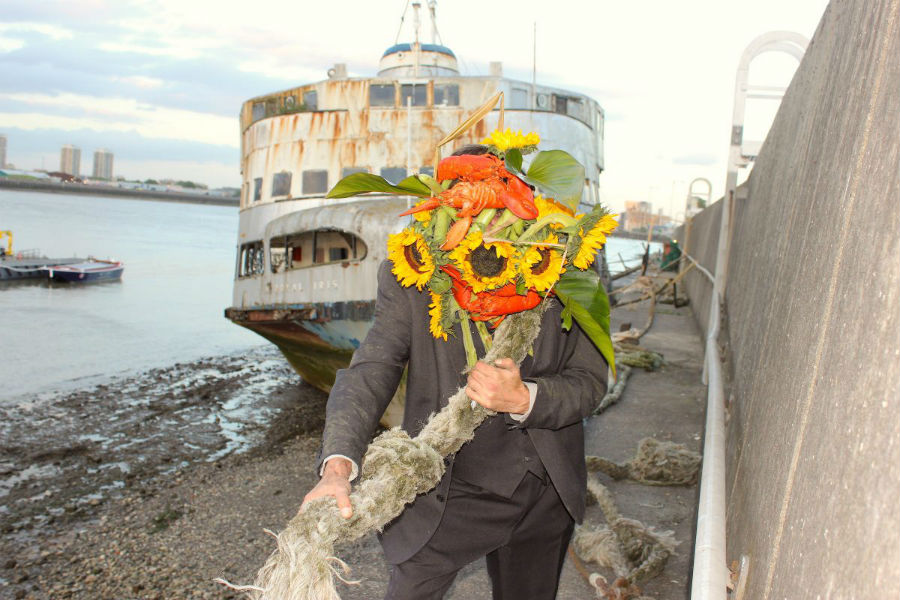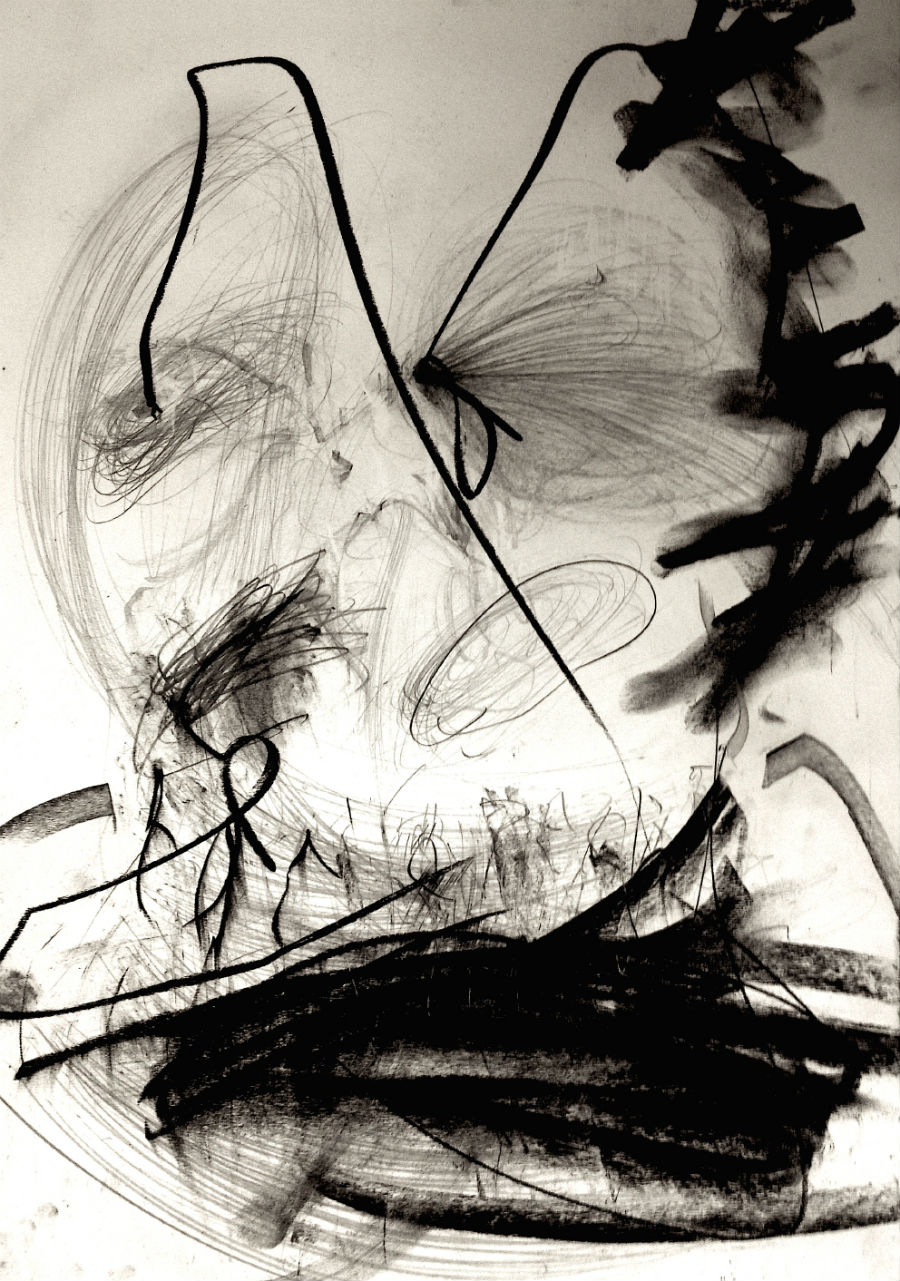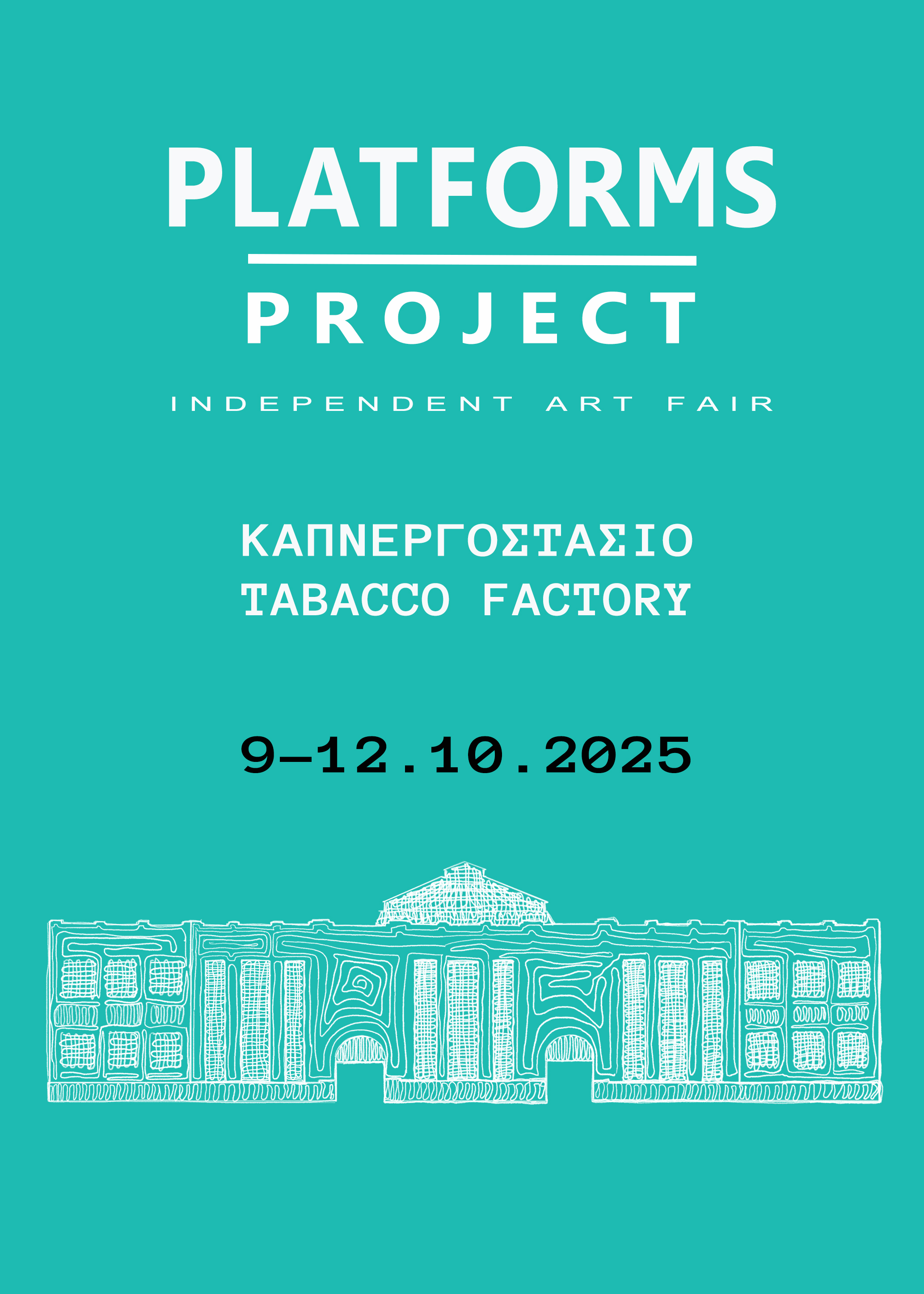On the occasion of Filippos Tsitsopoulos’s solo exhibition at Eleftheria Tseliou Gallery we interviewed the artist to discover more about the process behind his extravagant mask constructions, his expressive drawings and the connection between the two. The result was a half-hour monologue which we decided not to interrupt and transcribe with minimum editing in order to convey the artist’s stream of thought and unique personal narrative style.
Interview by Kiriakos Spirou
Images courtesy the artist

I graduated from the School of Fine Arts in Thessaloniki and then I left to Madrid for my master’s, where I lived from 1991 to 2012 with a little break between 1996-98 when I was in Athens. After Madrid I went to Liverpool for two years and after that I moved to London, where I still live. So I went through two different cultures that are also historical opponents: Spain and England. This whole trip from Athens where I was born to Thessaloniki and thereof has been extraordinary, albeit a bit dramatic. For example in Thessaloniki someone put a fire in the Fine Arts School and all my work was destroyed, my graduation project, everything. So when I went to Madrid I had nothing to show, only a few early photos. So I found myself in a foreign country without a background, and that made me forget what I had done. That turned out to be good, because I turned to painting in a much different way than what I would have done if I had stayed in Greece.
It was in Madrid where I met Julian Schnabel, who did a seminar at the school there, and after that I worked with two or three new galleries. At that time I was doing action painting, which was in trend in Spain and America but not so much in the rest of Europe. But around 2000 I felt that doing this kind of art didn’t allow me to express all the things I had felt as a little child or my relationship with theatre. My father was an actor playing classical roles mostly for the National Theatre, so I had a relationship with dressing rooms, backstage, rehearsals, all that... And I couldn’t express all that, especially through this kind of painting. I started looking for another medium wondering what could the way be to express this, and at some point when I was full of memories and things that I didn’t know what to do with, the last drop fell in the glass and I wore the first masks. In a sense it was the moment when I wore my materials for the first time.
That turning point was in 2002, when I started playing some monologues and filming myself doing that. I was interested in the relationship between the monologue, the text, with other texts—at first I mixed up texts and I still do—but I was interested in the idea of “ridiculing” the text, and ridiculing oneself through that. I found an absolute concept and a condition from our own reality. Because we can be listening to a text and at the same time we can detach ourselves from it, like for example one can be listening to a Bonnie Tyler song and at the same time reading Queen Margaret’s monologue. So I used this mixing of texts to make weird combinations of things that go against each other.
It was about that time that with the death of my father in 2006 there was an explosion in my practice, because I found myself having to deal with his memory and the family’s memory intertwined with the memory of the theatre. This started simply by opening my father’s drawers and gathering his belongings from all around his house. In one of the drawers I found an archive of cassettes with recordings from his rehearsals, many of them. And in some of them I found myself holding the text for him and giving him cues; I found my mother also giving him cues. The recordings were an exchange of theatrical lines between my parents... All these texts were from Shakespeare, and were recorded from 1955 to 2006, he never stopped acting. And of all the books from his collection he left on his desk a study about the human soul and funerary rituals in different cultures. It was more like a collection of things that people do after someone has passed away. So in Oceania for example when people are mourning they put squids and fish on their faces, because they believe heaven is in the sea and by doing that they come closer to their dead.
That’s when I first used objects like fish and squids on my face and played the first monologues that had to do with these tapes I found. Inevitably, I played some of my father’s monologues as well. This was like therapy for me, I could hear myself breaking into many tiny pieces and each piece brought a memory, and I put all the pieces together to create a huge body of work that I called Craze. This was a series of 72 videos which I produced frantically: I put on my face anything you can think of in order to embody another character, I played pieces from Feste, the fool in Shakespeare’s Twelfth Night, as well as other texts my father had played. All this brought me in a situation that was a lot like live art, it was a live event that was happening in front of the camera and the mask was alive too in a way. And everything became something else: there was no text, there was no theatre, there was just this explosion of emotion, all this things that was happening to me which later on became my way of understanding art and reality, to see where theatre ends and life begins.
This brought me to a period where I found myself in a completely different situation. I did a lot of things in Madrid with the masks and some good exhibitions where I showed the Craze series. At the same time I was working at the Prado Museum giving workshops, where I was influenced by classical art, Flemish Art, Velasquez, Goya... All this ridicule we see in art we can also find in Goya for example, like in his black period or his etchings. We can see it in Flemish art like when we see demons farting or other silly things. At the same time we have a very important element which is empathy. Empathy is important because it’s something we often undermine in theatre or art. For example Brecht had enforced a distancing between the actors and the public, and when the audience felt close to a character he made the actor perform “backwards” and make the audience feel that he was ridiculing his part. This is also present in Hieronymus Bosch and the way he depicts people or demons, or in the way old art treats its symbols and so on. In other words there is sympathy for a character that is transformed to sarcasm or spite. These are things we find in many places, from Victor Hugo to Shakespeare.
Something that always interested me in Shakespeare is what his contemporaries said about him. Some said he was obnoxious, that he had no talent, others said that he had too much talent, so much that he was cancelling himself. Some said that he was extroverted, others that his plays were written by the other actors... They said everything you can think of, and everything contrasting to each other. These are the elements that I eventually used to make the idea of Shakespeare in my head. Not with his texts but with what others wrote about him. This brought me to the next step which is basically how to reconstruct a myth.

When we are making a myth we need a living symbol, something to feed out myth—in my case it was my father and his memories. Everything is myth because the only thing that exists is the reality we are in now, in this moment. Everything else is past or has not been said yet or will never be. Therefore we’re always talking about an assumption. Around the time I was thinking about these things I found this amazing ship in London. I have to mention this because it was very important for me. The boat was called Royal Iris, and it was a ferry boat that I found abandoned on the Thames. Later I discovered that the Beatles used to play on it every Friday and Elvis Costello on Saturdays. It’s the boat that Gerry & the Peacemakers mention in the song Ferry Cross The Mersey (1965). I asked the owner to do a performance at the place where the boat is now, and take the sorrow out of the boat, because it’s been abandoned there for years. So I took the monologue from Tennessee Williams’s The Glass Menagerie, tied myself with the ropes hanging from the ship and recited the text as I was trying to pull the boat from Thames back to Liverpool. Of course I fail, and in my attempt I fall down in the mud. Throughout this event I was wearing my masks and talking to the boat. All this obsession of mine with this subject made people back in Liverpool remember that this boat still exists and a mad man that puts all sorts of things on his head found in somewhere on the Thames. And through that they invited me from Hull UK City of Culture 2017 to present this series with the boat and do a series of performances and workshops. So all’s well that ends well. Shakespeare again!
It’s perhaps through Shakespeare’s comedies that I found the elements that were interesting to me as to how I can talk to objects, how to extract sorrow from objects. And develop a kind of performance where I say the words of these objects’s owners, or talk to the owners directly. That brought me to a project that I called Let’s Go, as in “OK, enough with the past, now what?”. So I would talk to chairs that were very old and worn, I talked to coffee shops, to houses, to windows—I did a crazy series of performances in London and people would see me and wonder who this madman was. I presented this series at Tate Modern through the Tate Proposals programme, and also at the Serpentine Gallery with the help of Hans Ulrich Obrist, where I did a series of actions related to the questions of what theatre is and what it means to negate reality.
The idea of negating reality came from theatre critic Jan Kott—a Polish who lived through World War II and whom I had the fortune to meet when I was still a child in 1972. Jan Kott had come to Katina Paxinou Theatre in Athens to see Paxinou perform, and my father was playing with her. And because my mother was working until late I was usually left backstage to wait for her to come and pick me up after work. So for a month this nice man was playing with me and drawing with me while I was waiting for my mother, and that man was Jan Kott. Much later I discovered that he was a remarkable person who talked about living theatre and living language, he was a translator from French to Polish and from Polish to English and from English to German. He translated Shakespeare’s work in these languages. After many years his friend Peter Brooke decided to translate Kott’s translations back into English, which changed the texts completely. Brooke liked that so much that he decided to stage them in the theatre, and that’s how Kott’s texts became known as the craziest thing in theatre.
So for my London performances I was playing Jan Kott in London, and I replaced all the scenes from his books—his real life events from the war in Poland—one by one with locations in London and made a film with my masks. In his book The Theatre of Essence there’s a point where he’s talking with Ionesku by the river Vistula in Poland, and I transported that scene by the Thames. I was Jan Kott talking to myself, because Ionescu is dead. So this relationship created a new kind of performance where you basically can represent someone but place them in a country different from the one they live in. And that project was called Kage where K for Kott.
That’s how I continued my story in relation to art and how to work with masks using living materials, in relation to what these materials mean to me, how the voice comes out of you and what is time in performance and in theatre... And by that I mean this: when we go to a play and we see a king on stage, we have the time of the king. Then we have the time of the actor working from five to seven, then we have the time of the break and the time of the city. All these four times also exist in performance art plus the time of the performer. Through my monologues on the street, at Tate Modern and other places I merge all these times into one; the result is a new system for me to see the videos and art mixing monologues while wearing masks and observing external scenes and actions and things I do again in masks. The result of all this is what we see here at Eleftheria Tseliou Gallery today, where in all this we can try to answer the question whether the mask allows us to communicate with the world or not, to see what others see and what we feel.

When wearing these masks we feel the silence and the pain from some things, and which stick to our face like a close-up of nature itself with all its weight and folds and lines. After using a mask I draw these lines, I try to remember them and the points that hurt while I was wearing the mask in this or that performance. At the same time I want to see what do people see from the outside, what is this little monster it conveys with its legumes and meats and fish and flowers... What are these two faces and where do they meet? Is there loneliness inside the mask? Is there reaction to the outside of it? A laugh? A selfie with the weird guy? There’s always a dialogue that replaces communication. As John Berger said, art and communication have one thing in common: none. So what is interesting here is whether we’re producing art and whether the product we’re producing—which is our self externalised as art—exists on its own. In other words, whether there’s self-containment or if it needs other things. That’s the most important question.
This exact question was posed to me by Jan Fabre with Joanna De Vos in Belgium as “whether art is lonely”. It was an enquiry in relation to Géricault’s The Raft of the Medusa, a famous painting that also had to do with cannibalism—which in turn is something that exists from antiquity and even in Jan Kott’s books it’s mentioned that it was called theophagy. Perhaps theophagy is cannibalism amongst the gods, these are not new things. So we had Géricault’s Raft and Jan Fabre invites a few artists who had collaborated in the past with Jan Hoet, who is a well-known historian, as a tribute to him after his death. I decided to do a performance that included a whole story about how things move across spaces in a monologue and examine what kind of texts I can say, how I feel when I negate myself on stage or how to become part of the Raft myself.
So I went to do this performance in Belgium where I had a series of frames and balloons that in the end I broke them all and it all became a raft and I was floating in this sea of texts I was saying. It all had to do with heaven and hell and ended with a story that also had to do with Jan Hoet. Basically it was a text that came from Denys Zacharopoulos, who knew Jan Hoet and it was about a moment in Documenta when he was co-director: a group of former Nazi officers who were 80 years old at the time visited him with a copy of the book “Forbidden Art” and told him that they grew up with that propaganda and wanted him to show them what they had missed and hadn’t felt. And Jan Hoet told Denys Zacharopoulos that he should give them a tour, and it was a shocking moment. So I used a text that Zacharopoulos wrote on Facebook to conclude my performance in Belgium that ended with something like this: the tears that are not shed fall in our souls and their saddened drops hammer our tired heart. They were words from Goethe’s Werther, and also the end of all the things that brought me to this gallery with these monologues as well as the mould of pain recorded with pencil on these drawings.
Filippos Tsitsopoulos's exhibition Is Art Lonely? continues at Eleftheria Tseliou Gallery through 14 April 2018. For more information visit the exhibition listing here.
